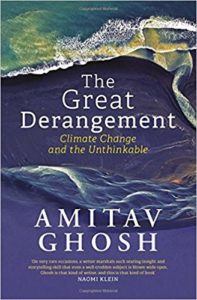 Ghosh’s non-fiction, short book on climate change The Great Derangement is a departure from his forte – the great Asian historic novel. It has all the classic Ghosh hallmarks with meticulous research: instancing the use of coal, oil and gas in pre-colonial Burma and China; a keen understanding of science previously revealed in his novel The Calcutta Chromosome; and the virtuoso use of language we expect from him.
Ghosh’s non-fiction, short book on climate change The Great Derangement is a departure from his forte – the great Asian historic novel. It has all the classic Ghosh hallmarks with meticulous research: instancing the use of coal, oil and gas in pre-colonial Burma and China; a keen understanding of science previously revealed in his novel The Calcutta Chromosome; and the virtuoso use of language we expect from him.
The question the novel poses is why literature has been so perfunctory in its engagement with climate change. The evidence of clear-and-present danger from climate chaos has been with us for decades. As Ghosh observes, first hand in the case of a Delhi tornado, extreme weather episodes are becoming more common place despite their statistical non-likelihood. This could provide a human backdrop for any budding author of climate change fiction.
Ghosh’s explanation of literature’s silence is one of artistic viewpoints and time-scales. Classic novels have a small number of actors and the action occurs over periods extending from a few days to a few decades. Few novels attempt to handle people en masse or engage with time frames of centuries which is the horizon over which the impact of heightened greenhouse gas levels will fully manifest. Would Life in a Gulag been as successful as A Day in the Life of Ivan Denisovich?
But, according to Ghosh, few authors have attempted the great climate novel. Ghosh’s list – Atwood, JG Ballard, McEwan, Le Guin, Lessing – puzzled me because scarcely any of the books listed were about climate change, they were largely big literary figures’ journeyman efforts at dystopic/alt-future novels. For instance, JG Ballard’s The Drowned World (1962) quite understandably given its vintage doesn’t go into the science of why London is submerged. Lessing’s excruciating Canopus series uses sci-fi to unsuccessfully examine many social issues aside from climate change. McEwan’s Solar is a “McEwan” book starring a scientist working on solar energy. You could search and replace “solar” with “herpetology” and not notice any disruption to the plot.
Novels have engaged with climate change. My own novel The Rising Tide is more firmly rooted in climate science, in its consideration of the aftermath of collapsing Greenland ice-shelves, albeit fast-forwarded, seen through a teenage prodigy’s eyes. Kim Stanley Robinson’s New York 2140 writes of a post-sea level rise world which engages with how the human spirit will continue, after the climate fall. The YA book After Tomorrow talks about by refugee flows and monetary collapse triggered by climate change.
The last section of Ghosh’s book is a quirky textual analysis of two decidedly non-fiction documents produced in 2015, the hottest year on record, Pope Francis’s encyclical letter Laudato Si’ and the UN-FCCC’s Paris Agreement. Literature’s disengagement is all too evident 2016’s Booker was awarded to a book about someone selling weed and water-melons!
For someone like me who works on climate change and energy issues as an economist, policy wonk and author the book was a fascinating exposure to some different perspectives on familiar material. Ghosh’s main weakness was the incomplete efforts to engage with the sci-fi genre which is the style of literature that best engages with long term social issues. Thoroughly recommend.

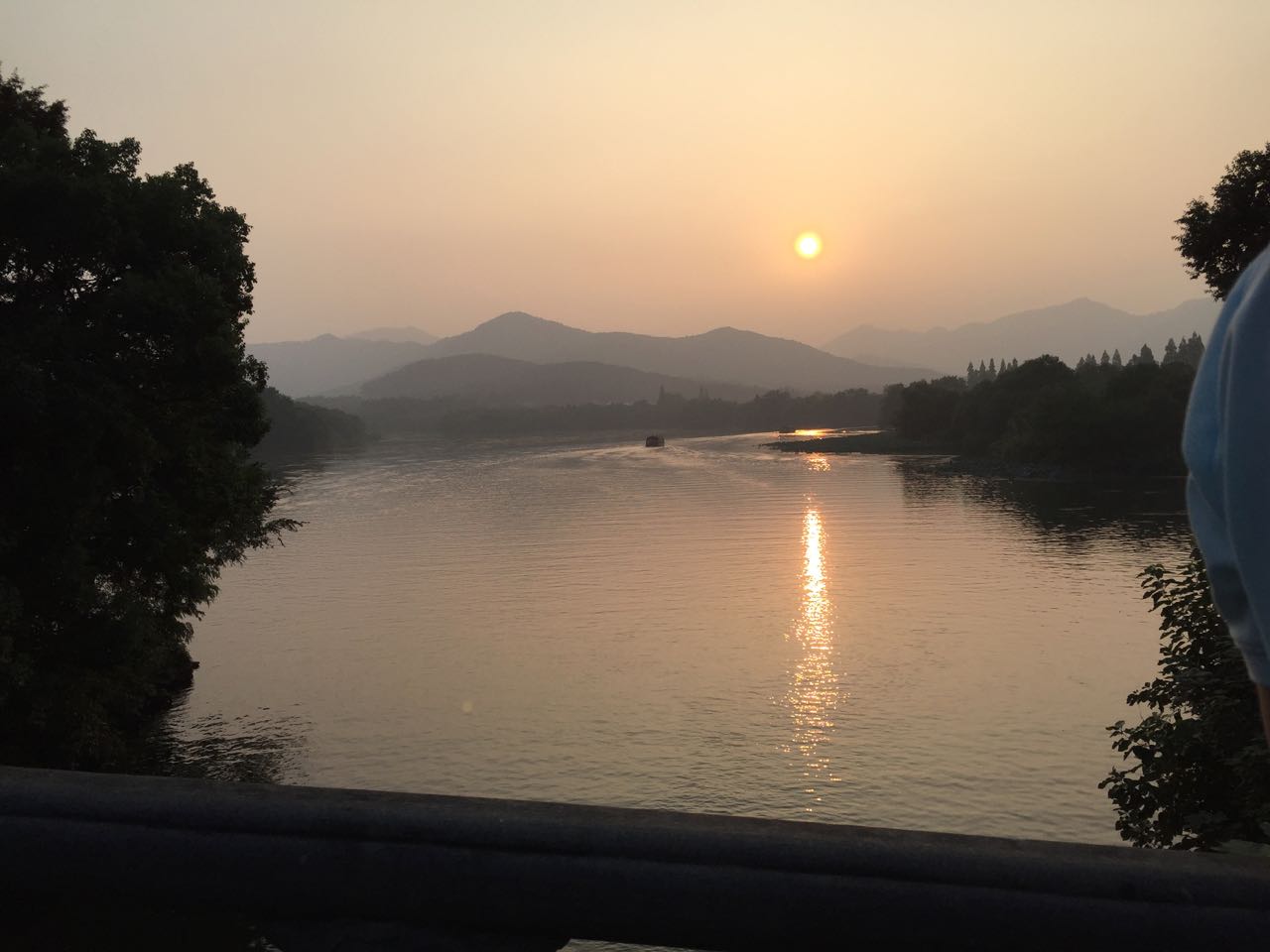 Hangzhou is regarded by many Chinese people as the country’s most beautiful city. Its Xili (West Lake) is garlanded by stunning villas that have inspired artists and poets for centuries. Its delicate pagodas are filled with newlywed couples spooning over the water. The lake’s sub-divided waters are criss-crossed by delicate stone and wooden bridges and garrotted by a 3km grassy causeway. Around it but within the city’s boundaries are lovely restaurants, mountains, many excellent museums, rice fields and tea plantations all easily accessed by bus or bike. It’s always been famous within China and was even briefly capital during the Southern Song dynasty.
Hangzhou is regarded by many Chinese people as the country’s most beautiful city. Its Xili (West Lake) is garlanded by stunning villas that have inspired artists and poets for centuries. Its delicate pagodas are filled with newlywed couples spooning over the water. The lake’s sub-divided waters are criss-crossed by delicate stone and wooden bridges and garrotted by a 3km grassy causeway. Around it but within the city’s boundaries are lovely restaurants, mountains, many excellent museums, rice fields and tea plantations all easily accessed by bus or bike. It’s always been famous within China and was even briefly capital during the Southern Song dynasty.
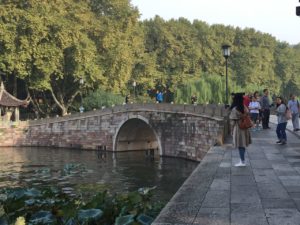 Maya and I went there during the mid-autumn festival in October. Along with Chinese New Year it is the biggest migrations of mammals anywhere in the world, no matter what David Attenborough silkily tells you about his wildebeest. Shockingly, Maya and I weren’t Hangzhou’s only visitors that week. Hangzhou’s gazetted must-see tourist attractions were rammed with tourists from seven in the morning till bed-time. I’ve always been baffled by how Mao persuaded his fledgling People’s Liberation Army to tour China’s inhospitable southern perimeter in Long March. Then I saw Chinese
Maya and I went there during the mid-autumn festival in October. Along with Chinese New Year it is the biggest migrations of mammals anywhere in the world, no matter what David Attenborough silkily tells you about his wildebeest. Shockingly, Maya and I weren’t Hangzhou’s only visitors that week. Hangzhou’s gazetted must-see tourist attractions were rammed with tourists from seven in the morning till bed-time. I’ve always been baffled by how Mao persuaded his fledgling People’s Liberation Army to tour China’s inhospitable southern perimeter in Long March. Then I saw Chinese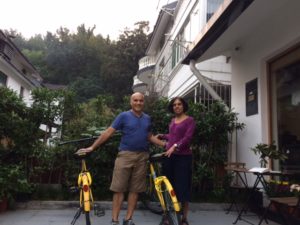 Our hotel owner suggested Maya and I download one of the app. (We communicated with him via Wechat’s incredibly effective speech translator.) For the next three days we’d pick up and drop off bikes bikes where we liked. Holding our phones over the bikes’ QR code unlocked it, when we were done we locked the bikes up again. There were occasional hitches but it worked pretty smoothly. It is obviously hugely popular with young and old. In some locations people scrambled for our bikes the moment we disembarked. (Hong Kong’s service GoBee.bike set up by Raphael Cohen is good but still glitchy, without the big-bucks backing of its Chinese rivals, that operates in Hong Kong’s New Territories.)
Our hotel owner suggested Maya and I download one of the app. (We communicated with him via Wechat’s incredibly effective speech translator.) For the next three days we’d pick up and drop off bikes bikes where we liked. Holding our phones over the bikes’ QR code unlocked it, when we were done we locked the bikes up again. There were occasional hitches but it worked pretty smoothly. It is obviously hugely popular with young and old. In some locations people scrambled for our bikes the moment we disembarked. (Hong Kong’s service GoBee.bike set up by Raphael Cohen is good but still glitchy, without the big-bucks backing of its Chinese rivals, that operates in Hong Kong’s New Territories.) Vladivostok is a city of 600,000 in the Far East of Siberia. Russia grabbed it opportunistically in 1860, back when the Qing Empire had been enfeebled by the Opium Wars and the vicious Taiping Rebellion that left 20 million dead. Russia quickly consolidated its grip expelling the Chinese and transferring people from Ukraine and Belorussia: first by land and ship and by rail once the Trans-Siberian Railway was built.
Vladivostok is a city of 600,000 in the Far East of Siberia. Russia grabbed it opportunistically in 1860, back when the Qing Empire had been enfeebled by the Opium Wars and the vicious Taiping Rebellion that left 20 million dead. Russia quickly consolidated its grip expelling the Chinese and transferring people from Ukraine and Belorussia: first by land and ship and by rail once the Trans-Siberian Railway was built. I’ve long wanted to go to Vladivostok. The word Vladivostok conjures a far-away, mystic place of exile like Timbuktu, Mandalay or Coventry. Over summer I read A Day in the Life of Ivan Denisovich vicariously commenting on many drafts of my son’s school essay. In the book the bleak Siberian gulag is set in a vast open terrain and a bitterly cold climate. The book gets the vast, openness right. Far East Russia is 20 times bigger than UK, but its population of 6 million (and declining) is but a tenth of UK’s.
I’ve long wanted to go to Vladivostok. The word Vladivostok conjures a far-away, mystic place of exile like Timbuktu, Mandalay or Coventry. Over summer I read A Day in the Life of Ivan Denisovich vicariously commenting on many drafts of my son’s school essay. In the book the bleak Siberian gulag is set in a vast open terrain and a bitterly cold climate. The book gets the vast, openness right. Far East Russia is 20 times bigger than UK, but its population of 6 million (and declining) is but a tenth of UK’s.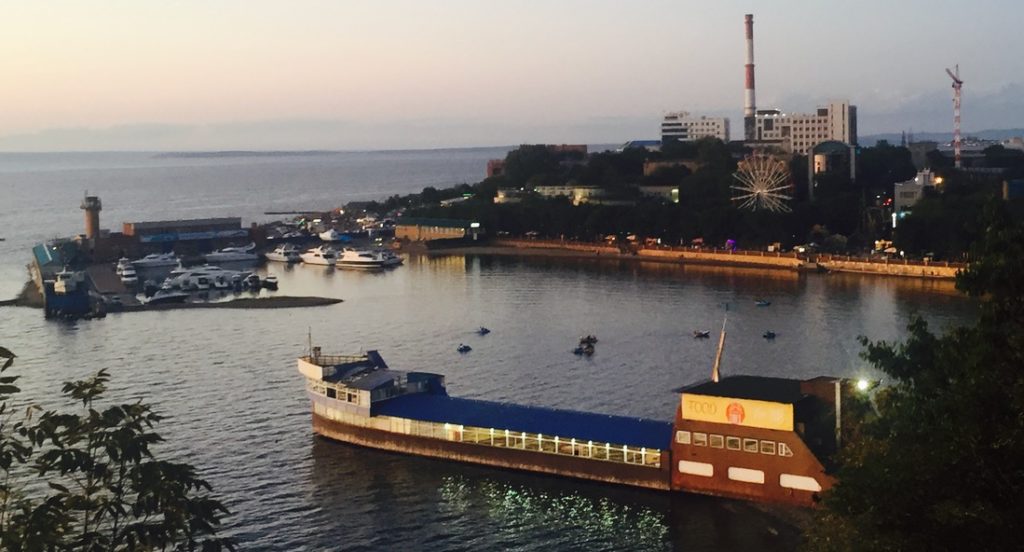
 I found the contrast between Hong Kong and Vladivostok jarring. The flight is only four-hour but you land in an alien environment. Everyone on the plane was young, Slavic and athletic looking, or they were me. The lack of diversity is at least in part due to Russia’s anti-tourism policy, you couldn’t invent a more Byzantine process to get a visa. The other big difference is Vladivostok has space to burn. There’s no jostling for territory on the roads, pavements, lifts, or restaurants. You can finally stretch your wings. Instead of Hong Kong’s fastidious maintenance of its infrastructure we have Russia’s worrisome neglect. Outside the center’s conference-friendly ambit roads are cratered and the paint on the old buildings peeling. A funicular rattles and creaks as it climbs from the touristic shore – where you can explore the inside of Submarine S-56 – to the hill-top’s viewing point. The people have so much environment, trashing it doesn’t seem to matter. Unlike Hong Kong’s 24/7 work culture, Vladivostok is more interested in having fun on the beach, going for a beer, playing football with the kids.
I found the contrast between Hong Kong and Vladivostok jarring. The flight is only four-hour but you land in an alien environment. Everyone on the plane was young, Slavic and athletic looking, or they were me. The lack of diversity is at least in part due to Russia’s anti-tourism policy, you couldn’t invent a more Byzantine process to get a visa. The other big difference is Vladivostok has space to burn. There’s no jostling for territory on the roads, pavements, lifts, or restaurants. You can finally stretch your wings. Instead of Hong Kong’s fastidious maintenance of its infrastructure we have Russia’s worrisome neglect. Outside the center’s conference-friendly ambit roads are cratered and the paint on the old buildings peeling. A funicular rattles and creaks as it climbs from the touristic shore – where you can explore the inside of Submarine S-56 – to the hill-top’s viewing point. The people have so much environment, trashing it doesn’t seem to matter. Unlike Hong Kong’s 24/7 work culture, Vladivostok is more interested in having fun on the beach, going for a beer, playing football with the kids. I liked the phlegmatic can-do-ness permeating the culture. Channel surfing you can catch Putin looking inscrutable and insouciant, not harangued and shifty like a Hong Kong politician. Instead of a shopping channels, I found a DIY channel where the presenter showed us how to repair a broken pair of glasses with glue and Sellotape (you too can sport the Michael Foot look).
I liked the phlegmatic can-do-ness permeating the culture. Channel surfing you can catch Putin looking inscrutable and insouciant, not harangued and shifty like a Hong Kong politician. Instead of a shopping channels, I found a DIY channel where the presenter showed us how to repair a broken pair of glasses with glue and Sellotape (you too can sport the Michael Foot look).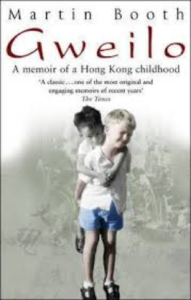 Just finished reading Martin Booth’s autobiographic book, the third of the Gweilo canon I’ve read these past few months. The three books couldn’t be more different. John Lanchester’s novel Fragrant Harbour covers the period between the end of the first world war and the turn of this century. He skilfully weaves three narrators and three narratives into an intergenerational saga. James Clavell’s Taipan is a swashbuckling story of an early Victorian privateer who outwits mandarins, pirates and business rivals to found an enduring business dynasty that loosely based on the Jardine story. Gweilo is set in the two-year stretch of time between 1952 and 1954 as seen through the eyes of the 8 to 10 year-old Booth. Booth’s father is a low ranking civil servant and his mother a vivacious and wise homemaker.
Just finished reading Martin Booth’s autobiographic book, the third of the Gweilo canon I’ve read these past few months. The three books couldn’t be more different. John Lanchester’s novel Fragrant Harbour covers the period between the end of the first world war and the turn of this century. He skilfully weaves three narrators and three narratives into an intergenerational saga. James Clavell’s Taipan is a swashbuckling story of an early Victorian privateer who outwits mandarins, pirates and business rivals to found an enduring business dynasty that loosely based on the Jardine story. Gweilo is set in the two-year stretch of time between 1952 and 1954 as seen through the eyes of the 8 to 10 year-old Booth. Booth’s father is a low ranking civil servant and his mother a vivacious and wise homemaker.